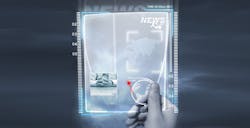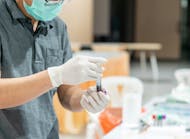Using just a single drop of blood, University of Wisconsin-Madison researchers have developed an accurate tool for diagnosing even mild cases of asthma. This handheld technology, which uses a previously unknown correlation between asthmatic patients and the most abundant type of white blood cells, allows clinicians to diagnose asthma even when patients are not presenting symptoms. The team described its findings online in the journal Proceedings of the National Academy of Sciences (PNAS).
The researchers focused on the cell function of neutrophils to show accurate asthma diagnosis. Neutrophils are generally the first cells to migrate toward inflammation. The body emits chemical signals in response to inflammation or wounds, and the neutrophils detect those chemical signals and migrate to the site of the wound to aid in the healing process. Researchers can track the velocity at which the neutrophil cells migrate—the chemotaxis velocity—to differentiate non-asthmatic samples from the significantly reduced chemotaxis velocity of asthmatic patients.
Researchers developed the kit-on-a-lid-assay (KOALA) microfluidic technology, which allows them to detect neutrophils using just a single drop of blood. The KOALA diagnostic procedure is straightforward. Using simple lids and bases, diagnosticians place a KOALA lid, containing premixed chemicals, onto the base containing the blood sample. That chemical mixture triggers neutrophil migration, and researchers can automatically track and analyze the neutrophil chemotaxis velocity using custom software.
Study co-author David Beebe, PhD, emphasizes that using the KOALA lids makes the diagnostic procedure scalable, inexpensive, quick, and repeatable. “Instead of getting a box of media and staining solution and having to do a lot of manual manipulation, you would get the base for the fluid sample, the prepackaged KOALA lids, and to do any testing, just place a lid (or series of lids) on the base.” Read the study abstract.
Read more





